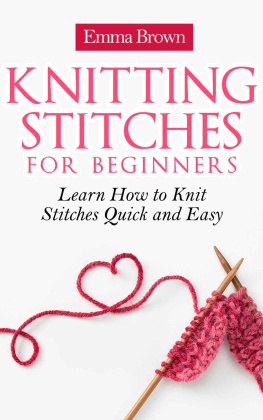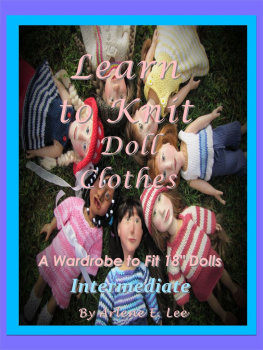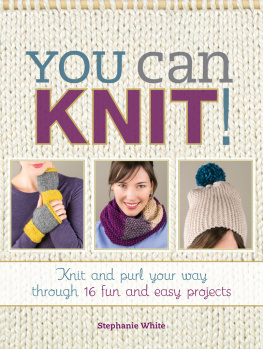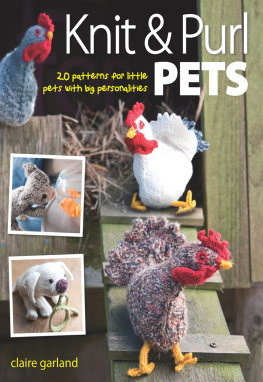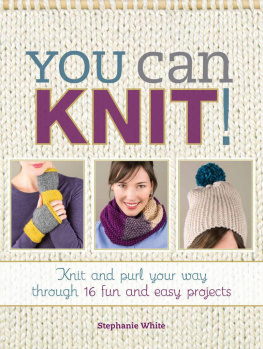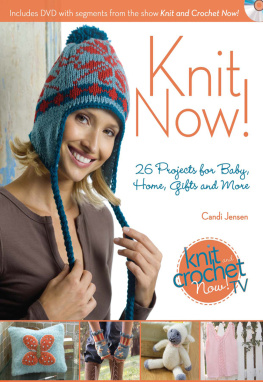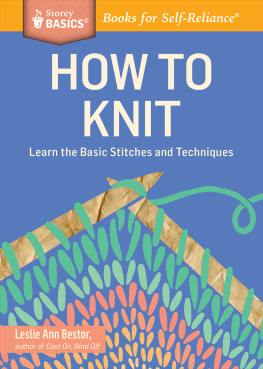Have you ever wanted to learn how to knit but thought it would take too long? The truth is you can learn to knit in just one day and be on your way to making your very first project. In this book you will learn how to knit from the very beginning and then work four original patterns to practice your skills. This book is geared toward anyone who has always wanted to knit, but thought the task was too daunting or time consuming. Once you finish this book you will be able to knit beginner patterns and be on your way to a lifelong journey with knitting.
CHAPTER ONE Yarn and Needles
Before we begin to knit, it is important you understand a bit about yarn, yarn weight, and gauge. Once we complete this chapter youll be ready to learn the basic stitches and techniques of knitting.
Yarn Basics
Yarn comes in three main types of fibers; animal, plant, and synthetic. Animal fibers include wool, alpaca, mohair, cashmere, and silk. Plant fibers include cotton, soy, bamboo, hemp, and linen. Synthetic fibers include acrylic, polyester, microfiber, and metallic threads.
Most yarn needs to be blocked after you get finished knitting it up. The exception is synthetic yarn. It rarely needs to be blocked. To block a piece dampen it and then roll it up in a big fluffy towel to remove the excess moisture. Lay it out flat on blocking mats or another dry towel and gently shape it with your hands. Begin at the edges and pin the project to the mat shaping it as you go. You may have to adjust the pins to get the correct size and shape to your project. Once youre happy with how it looks let it dry completely before you remove the pins.
Yarn Weights
Yarn come in weights from very fine to jumbo. Each weight has a recommended needle size and gauge. Gauge refers to the number of stitches across a row and the number of rows in a four by four square of knitting.
Yarn Weight Chart |
Weight | Description | Recommended Needle Size | Stitches in 4 |
| Lace | Fingerling, Size 10 Crochet Thread | 000-1/1.5-2.25mm | 33-40 |
| Superfine | Sock, Fingerling | 1-3/2.25-3.25mm | 27-32 |
| Fine | Sport, Baby | 3-5/3.25-3.75mm | 23-26 |
| Light | DK, Light Worsted | 5-7/3.75-4.5mm | 21-24 |
| Medium | Worsted, Afghan, Aran | 7-9/3.75-4.5mm | 16-20 |
| Bulky | Chunky, Craft, Rug | 9-11/5.5-8mm | 12-15 |
| Super Bulky | Super Bulky, Roving | 11-17/8-12.75mm | 7-11 |
| Jumbo | Jumbo, Roving | 17 and up/12.75mm and up | 6 or less |
For example if you use a medium weight yarn and size 8 needles a swatch of four inch knitted fabric should have 16 to 20 stitches in each row. Always knit up a swatch and compare it to the gauge of the pattern. If the swatch is too large or small you may have to adjust the size of the needles you are using or tighten or loosen your tension.
How to Read a Yarn Label
One of the best tools you have to choose the correct yarn is the yarn label. On the label youll find the fiber content, the weight, gauge, recommended needle size, and care instructions. Most yarn manufacturers use a standardized set of laundry symbols which you can find on the Lion Brand website.

On this label of Red Heart Super Saver yarn we see this is an acrylic yarn with a weight class of 4. The recommended needle size is US 8/5mm which will give you a gauge of 17 stitches across and 23 rows in a four inch square. The knitted project can be machine washed and dried at no more than 104 degrees.
When youre shopping for yarn be sure to look at the labels. If you see a dye lot purchase a few more skeins than you think youll need of the same dye lot so the colors will be consistent in your project.
Knitting Needles
Knitting needles come in many sizes. These range from very tiny needles used for lace knitting to big jumbo needles used for rugs. Needles are made of aluminum, bamboo, wood, and plastic. I have a set of aluminum needles that Ive had for years, but Id like to try some bamboo and wood needles to see how they feel. Id recommend purchasing a set of aluminum needles to start out with.
US Sizes | Metric Sizes | UK/Canadian |
| 2.0 | |
| 2.25 | |
| 2.75 | |
- | 3.0 | |
| 3.25 | |
| 3.50 | - |
| 3.75 | |
| 4.0 | |
| 4.5 | |
| 5.0 | |
| 5.5 | |
| 6.0 | |
| 6.5 | |
- | 7.0 | |
- | 7.5 | |
| 8.0 | |
| 9.0 | |
| 10.0 | |
| 12.0 | - |
| 16.0 | - |
| 19.0 | - |
Needles also come in different types. Straight needles are used for flat projects which are knitting back and forth in rows. Circular needles are needles joined by a cable which are used for knitting in the round. Double pointed needles have points at each end and are shorter than straight needles. They are used for small projects such as socks, baby hats, and other projects knitted in the round.

Straight Needles

Circular Needles

Double Pointed Needles
What You Need to Begin Knitting
You really dont need a lot of equipment to begin to knit. A good variety of common straight needle sizes (6-11), round stitch markers, row counter, shears, and yarn. You can purchase a row counter or just use a pencil and paper to keep track of what row you are on in a pattern. Round stitch markers are used to mark pattern repeats and the beginning of a new round when knitting in the round. Purchase the best supplies you can afford, but dont break the bank. You can find good quality fair priced supplies online or at your favorite craft or big box store.


